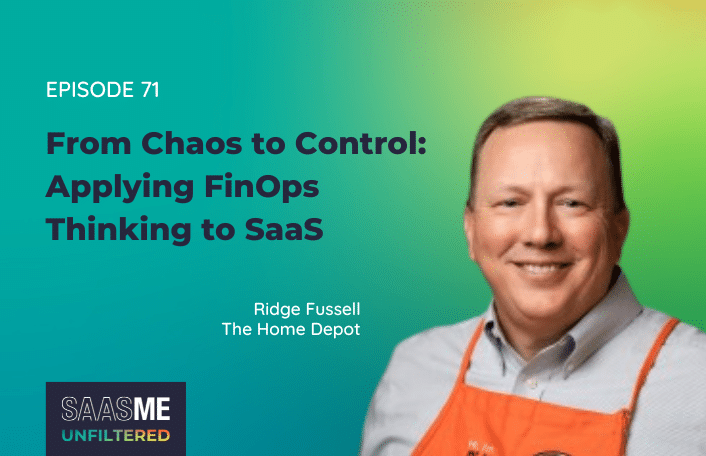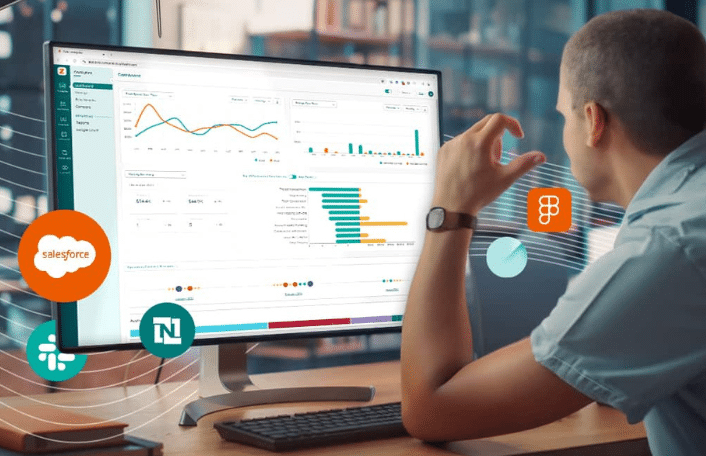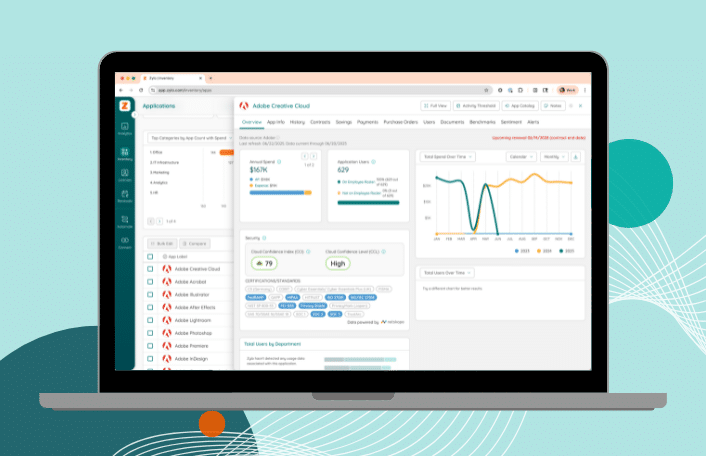
From Chaos to Control: Applying FinOps Thinking to SaaS
Table of Contents ToggleIt’s Easy to Make a Bad Software HireSaaS...
Back
Back
Search for Keywords...
Blog

Table of Contents
For many enterprise businesses, every employee in the organization shares a few things in common. First, a hiring manager invited them to join the team via hiring and onboarding.
Second, the expectation exists that a supervisor will monitor and help improve the employee’s performance through regular reviews.
And finally, if and when an employee leaves, off-boarding procedures protect the organization from risk.
Nearly every enterprise business uses documented processes to manage the lifecycle of an employee’s entire tenure with the organization. But few apply the same rationale when it comes to acquiring and managing the tenure of cloud-based subscription software.
In the age of digital transformation, businesses need labor and software to thrive. And akin to human labor, when cloud-based subscription software (also known as software-as-a-service, or SaaS) exists in an organization in unmanaged fashion, it creates avoidable risk.
Due to its low cost and ease of implementation, nearly anyone in an organization can “hire” or acquire software these days, not just IT teams. Zylo data shows that 74% of all SaaS spending now occurs outside of IT budgets.

But what if the approach for software acquisition mirrored the process for new hires? It means hiring managers would employ best practices based on subject matter experts. In this case, IT rather than HR.
Let’s take a walk through each stage of a SaaS application in an organization through the lens of a manager hiring an employee. In this way, we’ll demonstrate how creating application management lifecycle can deliver value and reduce risk.
When hiring an employee, you fill a gap in your organization created by an employee’s departure or in anticipation of growth. Once you identify the specific need and post a job description, you can expect to choose from a number of qualified candidates.
The same principle can apply to new software acquisition. For most gaps, multiple candidates may apply to fulfill the role you’re seeking to hire for. But finding the right fit is especially important. Just like the interview process, ask lots of questions to suss out the best candidate for your needs.
You also need to pre-qualify and vet new tools to prevent undue risk. Would you hire an employee without a background check? Do the same for your SaaS tools. An IT security audit represents the correlation to a background check. Ask the software vendor to provide customer referrals.
Companies don’t allow just anyone to hire new employees. Don’t let just anybody acquire SaaS, either.
Shadow IT typically grows due to the acquisition of low-cost software by individual teams or employees without a centralized strategy.
Individually, these tools or applications may not cost much, but cumulatively across an enterprise-sized company, they can create millions in unplanned spending.
For example, according to Zylo data in the 2025 SaaS Management Index, the average company underestimates its SaaS spend by 3X and number of applications by nearly 2X.
Related: Checklist for Assigning Strategic SaaS Ownership
For Zylo customers, a step toward reducing shadow IT acquisition comes from identifying rogue software throughout the organization. Zylo’s discovery process reveals the presence of the application as well as its attributes, including ownership.
After all applications and owners have been discovered, the next step involves mitigating unplanned software acquisition. This process may include designating which employees retain permission to acquire new software or prohibiting employee-based acquisition entirely.
Creating software review board or central review process represents another strategy. A review process ensures that new apps entering the organization meet financial, legal, security and compliance requirements, and do not duplicate existing software functions.
Related: AdRoll Improves IT Procurement via SaaS Visibility
You’ve selected your new software. It’s been on-boarded, integrated, and deployed to your workforce. Fast forward several months: Is the tool still executing as planned? Is it performing effectively?
In the case of an employee, a regular performance review by a supervisor helps answer this question. For many organizations, there is not a similar performance review process for cloud-based software. But many organizations could drive improved SaaS management by regularly monitoring the pulse of SaaS tool performance.
When enterprise customers deploy Zylo’s SaaS management platform, they also meet regularly with a Zylo SaaS consultant to discuss application performance. This includes highlighting end-user adoption and utilization data to indicate when and how frequently the application is being used.
On average, 40% of enterprise applications are inactive or underutilized. By adopting a SaaS application lifecycle management approach that examines application utilization on a regular basis, much like an employee performance review, small issues can be addressed before they become larger issues.
Related: 5 SaaS Benchmarks for Collaboration
As it turns out, the comparison that managing employees and SaaS applications are similar requires an adjustment. Because SaaS applications are subscription based with set renewal dates, they behave more similarly to contractors or temp employees than full-time hires.
One benefit of a temporary hire’s contract is the ability to allow it to expire if the relationship isn’t working effectively. The contract expires, the temporary hire moves on, no longer a part of the organization. On the other hand, if the temp or contractor performs well or exceeds expectations, their contract can be renewed
Yet, within this lens, many companies miss the opportunity to offboard SaaS applications, even when they’ve outlasted their usefulness. Enterprise organizations who work with Zylo process about two renewals every business day. The vast majority of these applications require at least 30 days notice to prevent automatic renewal, which underscores why it’s critical to develop an application’s renewal plan well ahead of the actual renewal data is critical.
Can you imagine a temporary or contract worker sticking around once their term had expired because you failed to notify them their contract would not be renewed?
Building a renewal calendar helps manage this portion of the SaaS application lifecycle. This helps application owners stay informed of notification periods. With a calendar in place, applications owners can make informed decisions based on application performance data to continue “employing” an application or to give it walking papers.
As an increasing number of organizations embrace the benefits of SaaS applications – lower cost, ease of use, and limited commitments – they also become increasingly aware of some of the drawbacks. These include their role in creating shadow IT, lack of built-in governance, and their contribution to unplanned spending.
By approaching SaaS applications in the organization in a manner that embraces a natural lifecycle with an emphasis on process – similar to how employees’ tenures are managed and administered with best practices – organizations can continue to tap their potential and minimize their risk.
ABOUT THE AUTHOR

Eric Christopher
Eric Christopher is CEO and Co-Founder of Zylo, the leading SaaS management platform. After 14 years of buying and selling software, Eric knew there had to be a better way to manage cloud applications within a company. Eric started his career in sales at ExactTarget from 2002 to 2010. He spent the next six years in Chicago leading sales teams at Shoutlet and Sprout Social Inc., and founded Zylo in 2016.

Table of Contents ToggleIt’s Easy to Make a Bad Software HireSaaS...

Table of Contents ToggleWhy Data Integrity Breaks DownWhat Does Data Integrity...

Table of Contents ToggleIt’s Easy to Make a Bad Software HireSaaS...

Table of Contents ToggleShelfware DefinedWhy Shelfware HappensPoor Organizational OversightShadow IT and...
| Cookie | Duration | Description |
|---|---|---|
| cookielawinfo-checkbox-analytics | 11 months | This cookie is set by GDPR Cookie Consent plugin. The cookie is used to store the user consent for the cookies in the category "Analytics". |
| cookielawinfo-checkbox-functional | 11 months | The cookie is set by GDPR cookie consent to record the user consent for the cookies in the category "Functional". |
| cookielawinfo-checkbox-necessary | 11 months | This cookie is set by GDPR Cookie Consent plugin. The cookies is used to store the user consent for the cookies in the category "Necessary". |
| cookielawinfo-checkbox-others | 11 months | This cookie is set by GDPR Cookie Consent plugin. The cookie is used to store the user consent for the cookies in the category "Other. |
| cookielawinfo-checkbox-performance | 11 months | This cookie is set by GDPR Cookie Consent plugin. The cookie is used to store the user consent for the cookies in the category "Performance". |
| viewed_cookie_policy | 11 months | The cookie is set by the GDPR Cookie Consent plugin and is used to store whether or not user has consented to the use of cookies. It does not store any personal data. |
